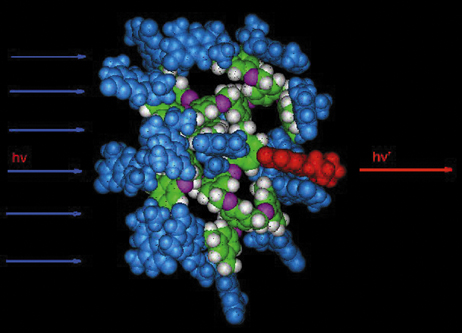
|
|
|
| "In these formative years of nanotechnology, one of the most frequently seen names in the scientific literature is that of Jean Fréchet, a chemist who holds a joint appointment with Berkeley Lab's Materials Sciences Division and the Chemistry Department of the University of California at Berkeley. That's because he's been a trailblazer in the development of what may well become the flagship of nanotechnology's building blocks, a class of polymerized macromolecules that have the potential to provide the most exquisitely tailored forms and functions ever realized outside of nature. These polymerized macromolecules are called dendrimers. |
"It is amazing how much can be done with such lovely molecules that owe much of their properties to the unique architectural and functional control achieved during their synthesis," Fréchet says. In 1989, he rocked the then fledgling world of dendrimers by introducing an entirely new approach to making them.
The word "dendrimer" comes from the Greek dendros, meaning trees, and meros, meaning part. Think of a tree in which each of its branches divides into two new branches after a certain length. This continues repeatedly until the branches become so densely packed that the canopy forms a globe. In a dendrimer, the branches are interlinked polymerized chains of molecules, each of which generates new chains, all of which converge to a single focal point or core.
The surface of a dendrimer globe bristles with numerous chain-ends, like fuzz on a ball of yarn. During synthesis, these chain-ends can be designed to perform specific chemical functions. For example, they may be electrically charged so that the entire dendrimer functions as a polyelectrolyte. Other features, including the external size and internal architecture of a dendrimer can also be controlled during synthesis. This makes possible the creation of interior cavities or channels with properties different from those on the exterior and opens the door to dendrimers serving as vessels or hosts for guest molecules. In this capacity, dendrimers could serve as targeted drug and gene delivery agents or nanoscale reactors for catalysis, in addition to building blocks for nanotechnology.
|
|
 |
| This light-harvesting dendrimer performs some functions of artificial photosynthesis. White light is gathered through chain-ends that behave like antennae and funneled into a chromophore in the dendrimer's core that then emits a single color of amplified light. | |
"The future of dendritic macromolecules lies in large part with cleverly designed syntheses that can deliver the structures best-suited for interesting applications," Fréchet says. "Our group is deeply involved not only in mission-oriented synthesis but also in learning more about the properties of dendrimers that take full advantage of their precise nanometer size, high functionality, and regular structural features."
Dendrimers were discovered in 1985. At that time, they were produced though a technique called "divergent" synthesis. This approach starts with a central core molecule out from which are grown successive concentric layers or generations of branches or "dendrons." In 1989 Fréchet, who was at the time a professor at Cornell University, and Craig J. Hawker, who was his postdoctoral associate, introduced the "convergent" approach to dendrimer synthesis. This approach starts with what will become the periphery of the dendrimers (the tips of the branches) and builds inwards. Two of these end-tips are attached to a branched monomer to form a dendron and the process is repeated until a desired size is reached. These interconnected branches are then attached to a core molecule.
Although the divergent synthesis has many good features, it requires the growing dendrimers to undergo tens and even hundreds of reactions simultaneously. This can lead to a mixture of dendrimers with similar structures rather than a uniform final product. The convergent synthesis, while requiring the same number of steps to build the dendrimer, only involves two reactions at each step of the growth process. This allows intermediate purification and results in a final product of purity unmatched by any other synthetic polymer.
"Much of our synthetic work draws its inspiration from nature," says Fréchet. "For example, we seek to encapsulate reactive sites in dendrimers to mimic enzymes and prepare nanoreactors that incorporate catalytic sites. Such dendrimers can also function as pumping devices, concentrating reagents in the cavity and expelling the products from the cavity."
Among the many exciting developments to emerge in recent times out of Freshet's laboratory has been the design of light-harvesting dendrimers that can perform some of the early functions of artificial photosynthesis. Photons are gathered over a wide area on the surface of the dendrimer through chain-ends that behave like antennae. Absorbed photons are then funneled down into the core which consists of a single chromophore that can either emit the photons back out as a single color of amplified light, or convert them into electrical or chemical energy.
"Energy transfer is through space not through bonds," Fréchet says. "It is remarkably efficient, almost quantitative. The system more closely mimics the behavior found in natural light-harvesting systems. It also functions as an optical amplifier."
Other areas of dendrimer development being explored by Fréchet, members of his research group, and other collaborators, include the exploration of several approaches to dendrimer-based drug or gene delivery systems, the use of dendrimers in molecular electronics for the storage of information or for nanoelectronics. They are also investigating novel dendrimers and other polymeric materials for use in a variety of separation and molecular recognition processes and as functional components of miniaturized "labs-on-a-chip."
As Fréchet said in a recent interview in Chemical and Engineering News magazine, "We are only just beginning to exploit the unique properties of dendrimers. The few families of dendrimers in widespread research use today cannot accommodate the huge variety of applications that could benefit from their unique properties and unusual behavior." - end -
| < Research Review | Top ^ | Next > |
